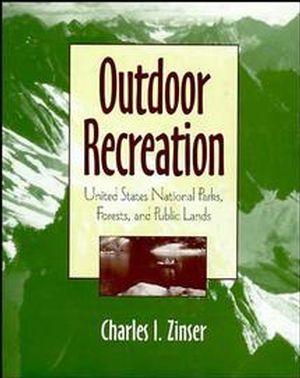Outdoor Recreation: United States National Parks, Forests, and Public LandsISBN: 978-0-471-05373-6
Hardcover
898 pages
August 1995
 |
||||||
Perhaps no other nation on earth devotes as large a portion of itspublic lands to recreational use as the United States. And whilemillions of Americans flock to our national parks, forests, andother public lands each year, these areas are also majorattractions for international visitors and an important source offoreign exchange. The allocation, location, planning, andmanagement of public lands for recreational use is now a majoractivity within each of the nation's four major land-managingagencies, and in several smaller departments as well.
This book presents an overview of the vast and diverse federalrecreation system, its historical evolution, methods of managementand development, and the different roles played by the NationalPark Service, the Forest Service, the Fish and Wildlife Service,and the Bureau of Land Management. It explores concepts in land-useplanning, examines relevant federal legislation, and presentsfederal concepts for preserving amenity resources. Rather than makean exhaustive presentation of current facilities and recreationalopportunities, author Charles Zinser uses a case study approach toillustrate and analyze programs and development principles found ineach of the major agencies. More than 300 tables, maps, andillustrations supplement the text.
An entire chapter is devoted to the recreational resources ofsmaller federal agencies, including the Army Corps of Engineers,the Bureau of Reclamation, and the Tennessee Valley Authority, allof which permit various forms of water-related recreation onreservoirs under their control. Many people are surprised to learnthat, in terms of recreational use, the Army Corps of Engineers isthe number-two federal agency.
Packed with helpful, practical, and authoritative information,Outdoor Recreation is a one-stop source on the availability,development, and management of recreational resources within thefederal system. It is a first-rate reference for anyone involved inforestry, geography, wildland or watershed management, land-useplanning and development, or creating recreational facilities. Itis also an ideal textbook for courses in geography and recreationaluse of public lands.
The most complete guide available to the federal recreationsystem
The system of federal lands devoted to outdoor recreation is asdiverse bureaucratically as it is geographically. At least eightfederal agencies administer recreational resources from mountain toseashore, from desert to glacier, in virtually every state andterritory of the nation. This one-stop sourcebook offers completeinformation on the acquisition, development, management, andprotection of these resources, including:
* Extensive coverage of recreational resources administered byfederal land-managing agencies that control one fourth of ournational territory
* A review of the basic concepts of land-use planning
* An examination of the federal legislation that created currentprograms and facilities
* Numerous maps, statistical tables, and illustrations notavailable from any other source
* Case studies that illustrate the practical impact of federalpolicies and concepts
* Examples of federal plans for protecting these resources,including: the National Wilderness Preservation System, NationalTrails System, and the National Wild and Scenic River System
This book presents an overview of the vast and diverse federalrecreation system, its historical evolution, methods of managementand development, and the different roles played by the NationalPark Service, the Forest Service, the Fish and Wildlife Service,and the Bureau of Land Management. It explores concepts in land-useplanning, examines relevant federal legislation, and presentsfederal concepts for preserving amenity resources. Rather than makean exhaustive presentation of current facilities and recreationalopportunities, author Charles Zinser uses a case study approach toillustrate and analyze programs and development principles found ineach of the major agencies. More than 300 tables, maps, andillustrations supplement the text.
An entire chapter is devoted to the recreational resources ofsmaller federal agencies, including the Army Corps of Engineers,the Bureau of Reclamation, and the Tennessee Valley Authority, allof which permit various forms of water-related recreation onreservoirs under their control. Many people are surprised to learnthat, in terms of recreational use, the Army Corps of Engineers isthe number-two federal agency.
Packed with helpful, practical, and authoritative information,Outdoor Recreation is a one-stop source on the availability,development, and management of recreational resources within thefederal system. It is a first-rate reference for anyone involved inforestry, geography, wildland or watershed management, land-useplanning and development, or creating recreational facilities. Itis also an ideal textbook for courses in geography and recreationaluse of public lands.
The most complete guide available to the federal recreationsystem
The system of federal lands devoted to outdoor recreation is asdiverse bureaucratically as it is geographically. At least eightfederal agencies administer recreational resources from mountain toseashore, from desert to glacier, in virtually every state andterritory of the nation. This one-stop sourcebook offers completeinformation on the acquisition, development, management, andprotection of these resources, including:
* Extensive coverage of recreational resources administered byfederal land-managing agencies that control one fourth of ournational territory
* A review of the basic concepts of land-use planning
* An examination of the federal legislation that created currentprograms and facilities
* Numerous maps, statistical tables, and illustrations notavailable from any other source
* Case studies that illustrate the practical impact of federalpolicies and concepts
* Examples of federal plans for protecting these resources,including: the National Wilderness Preservation System, NationalTrails System, and the National Wild and Scenic River System



